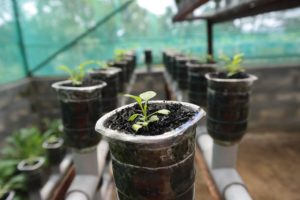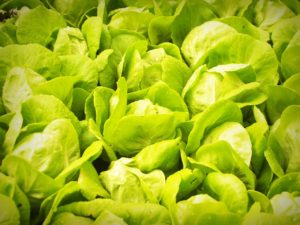Unchecked development along the banks of the Nile has taken over more than 90,000 acres of farmland since 2011, pushing many farmers into the desert. In addition, sewage and briny wastewater pumped into the Nile have made much of the country’s fresh water unusable. Realizing that traditional farming methods would use up the desert’s water supply within a few decades, Egyptians have turned to unconventional methods to farm as much produce as possible with the least amount of water.
Hydroponics—the art of growing plants without soil—is one solution to the growing scarcity of clean water and arable land in Northern Africa. Today, Egyptian farmers are growing lush, plentiful vegetables in the country’s dry, desert landscape using this technique, which some say originated in the Hanging Gardens of Babylon.
History
While there is some doubt that the Hanging Gardens of Babylon existed, tradition says this wonder of the ancient world was partially created with pre-hydroponic methods. King Nebuchadnezzar supposedly built the gardens for his wife, who came from a lush mountainous region and wasn’t used to the arid desert landscape of ancient Iraq.
According to the Greek historian Diodorus Siculus, the hanging gardens “sloped like a hillside” and were “thickly planted with trees of every kind.” Siculus also described hidden machines that carried large amounts of water from the river to the garden. Some historians believe that this sophisticated irrigation system was a precursor to modern hydroponics.
Modern hydroponics
 Scientists began working with modern hydroponic techniques in the mid-1900s, and over the decades gardeners and farmers have developed a number of methods of growing plants fortified by a nutrient-rich “medium.” This substance, which is usually a combination of materials that physically support the plant, allows the roots to grow as much as possible and supplies the roots with oxygen, water, and nutrients.
Scientists began working with modern hydroponic techniques in the mid-1900s, and over the decades gardeners and farmers have developed a number of methods of growing plants fortified by a nutrient-rich “medium.” This substance, which is usually a combination of materials that physically support the plant, allows the roots to grow as much as possible and supplies the roots with oxygen, water, and nutrients.
Farmers around the world have found great success with hydroponic techniques as scientists have continued to build upon ancient methods. As a result, modern hydroponics has expanded to serve the needs of a variety of growers, from individuals cultivating a few plants on their kitchen countertops to large-scale farms. Hydroponic setups also have been designed for balconies, rooftops, and other small spaces. One vertical system has been designed to grow in 1-meter square trays that can be stacked. These systems allow individuals and families to grow their own healthy, organic food, even if they live in small spaces in the middle of a desert.
The benefits of hydroponics are substantial, especially for bigger operations. These methods can yield eight times as much as traditional farming can produce on the same amount of land. Further, hydroponic farming does not require pesticides, which Egyptian farmers have abused for decades, and uses a fraction of the resources that traditional farming consumes.
Lettuce in the desert
Egyptian farmers have embraced the economy of hydroponics. Although setting up the system is often expensive, the systems are sustainable and significantly decrease the amount of water farmers need to produce healthy plants. One Egyptian farmer who grows salad greens outside Cairo said the hydroponic method uses 90 percent less water compared to traditional farming practices.
 Egyptian Hydrofarms, one of the first Egyptian companies to try hydroponic techniques, was founded by an Egyptian businessman who also had studied agriculture methods. The farm opened in early 2013, growing leafy greens along the Cairo-Alex Desert Road.
Egyptian Hydrofarms, one of the first Egyptian companies to try hydroponic techniques, was founded by an Egyptian businessman who also had studied agriculture methods. The farm opened in early 2013, growing leafy greens along the Cairo-Alex Desert Road.
At Egyptian Hydrofarms, machines pump nutrient-rich water through pots, where plants grow freely. Amr Bassiouny, co-founder of Egyptian Hydrofarms, told the press that hydrofarming allows him to grow many kinds of greens in the same greenhouse all year long. Egyptian summers typically are too hot for leafy greens to thrive, but hydroponic greenhouses regulate temperatures and allow for year-round cultivation.
The farm can grow as many as 1,000 heads of hydroponic lettuce in two months, and Bassiouny hopes to increase production soon. Stores around Egypt already sell greens from Egyptian Hydrofarms, and Bassiouny is considering exporting his produce abroad.
The operation employees about 20 people, many of whom are college graduates. Employees focus on maintaining the equipment, transferring seeds to the hydroponic systems, and harvesting the crops.
Dreams of the future
Egyptian farmers aspire far beyond providing produce for their region. Bassiouny, for example, has said that he believes his products have satisfied “the domestic demand,” and he envisions hydroponic methods providing healthy produce throughout the desert region. He wants Egypt to become a major hub for produce exports.
Other Egyptian farmers are expanding the types of produce they grow using hydroponic methods. Some are testing a variety of leafy greens on the market, and others are experimenting with vine crops. Several high-end chain grocery stores now carry hydroponic produce, and some Egyptian restaurants also are incorporating hydroponic produce into their menus.
Farmers also are investigating ways to fund and expand their work, which can take months of experimentation and development before the first crops can go to market. Agrimatic Farms, for example, has a profit-sharing model for new farmers who want to implement and operate a hydroponic system. Other growers offer volunteer programs that enable people to help at the farm and learn more about the process.

